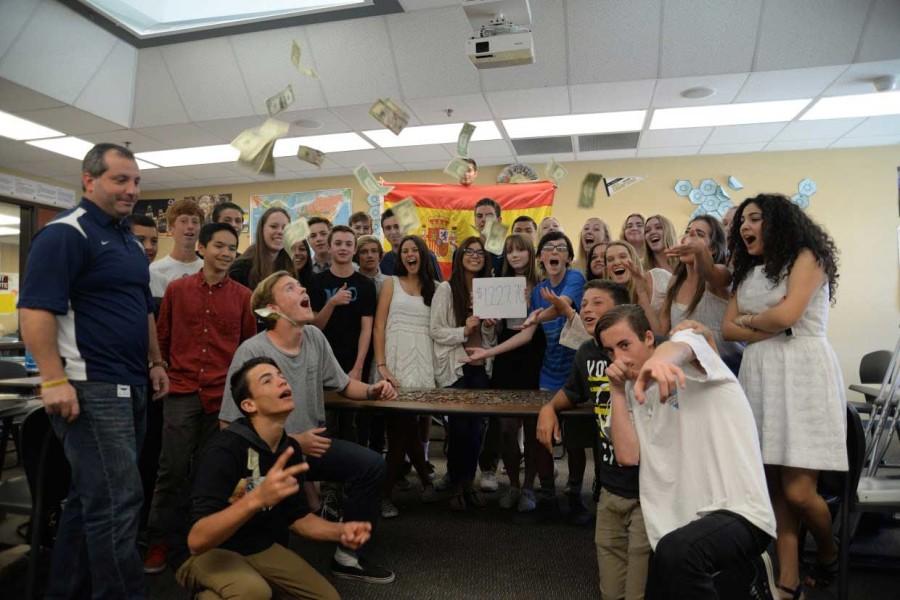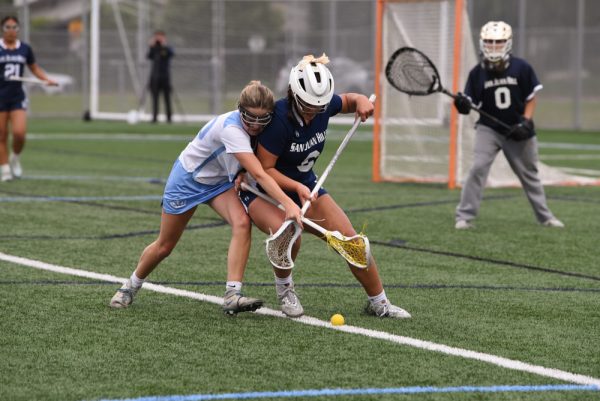Penny Wars Sparks Intense Classroom Rivalries
Competition good for charity but winner pays high price.
Suspicion of Serrano: Student’s in Serrano’s third period class celebrate their 1st place win in the Penny Wars. Mr. Serrano has been suspected of cheating since with the club’s organization. Photo by Andrew Fehlman
Penny Wars March 20th with Mr. Serrano’s class once again taking first place and winning a donut and pizza party.
The contest, sponsored by the Interact Club, aimed to raise over two thousand dollars for Heifer International, an organization that gives animals, wells, and schooling to impoverished families around the world.
“Two years ago we donated a cow and a sheep; we get the opportunity to choose what we want to donate to families in other countries… instead of just giving money, we would be giving animals, which is much more sustainable,” said Kayla Seyedjafari (12), Interact Club Co-President.
Fueled only by coins and sabotage, 3rd period classes competed with one another to raise the most money. But, there was a catch. Coins, such as pennies, nickels, dimes, or quarters, were the only way to earn positive points, and dollar bills yielded negative points for the class.
Therefore, sabotaging other classes was possible and even encouraged. Any paper currency placed in another teacher’s envelope would count against their total. It would require 100 pennies to offset a one dollar bill.
Club members noticed intense competition around the school, which came as no surprise, as classes struggled to topple Serrano as the reigning Penny Wars champion.
“I’ve seen a couple classrooms already and I think that Baker already has two five dollar bills. It’s just so fun,” said Seyedjafari early in the two-week competition.
Teachers sent students to sabotage rival classes by depositing dollar bills in their envelopes, including Serrano, who cried foul to Joe Snedeker, Interact Club adviser. Serrano claimed his class was interrupted 18 times in one day. Later, in an email to staff, Snedeker asked teachers not to allow students out during class to sabotage others, including Serrano.
Was this a tactic to win the contest?
According to Serrano, “Nobody has a chance to win no matter how much they try to put in our envelope.”
Why? Because Serrano offered to match every student contribution. And, according to students in his classes, he converted paper currency contributions by his students into coins, making it easier for students to give.
According to Seyedjafari he does it to motivate his students.
“The money he puts in himself doesn’t count toward the overall point total. It’s possible people may have felt discouraged by the large amount of money Serrano collected. But that could serve to motivate other classes to try harder,” said Seyedjafari.
“It raises an issue of fairness because I wonder how much students could raise as whole if all classes had an equal chance at winning, said Rob Lynde, history teacher. “I also think it’s bad for his back because his wife is going to make him sleep on the couch when she hears he owes the Interact Club $600 for this.”
“If we do it next year we’ll make sure to publicize the rules more clearly,” said Seyedjafari.
“Some of the teachers we visited were hard-core…Willis, Kaiser, and Serrano,” said Kiana Van Zanten (12), Interact Club Co-President.
The SJHHS Interact Club was excited to see students and teachers working together and having fun, all while contributing to a cause that would benefit families around the world.
“It’s a really fun and unique way to raise money,” said Interact Club Treasurer, Allie Biedermann (12).
Your donation will support the student journalists of San Juan Hills High School. Your contribution will allow us to cover our annual website hosting costs.

Jackie Ruedisueli is a sophomore at SJHHS who loves to write about everything. In fact, past teachers have requested Jackie not write so much. Teachers...










